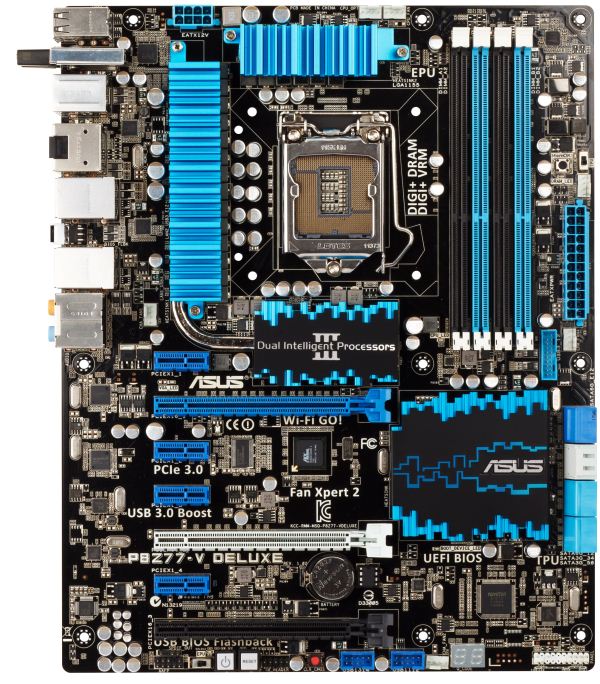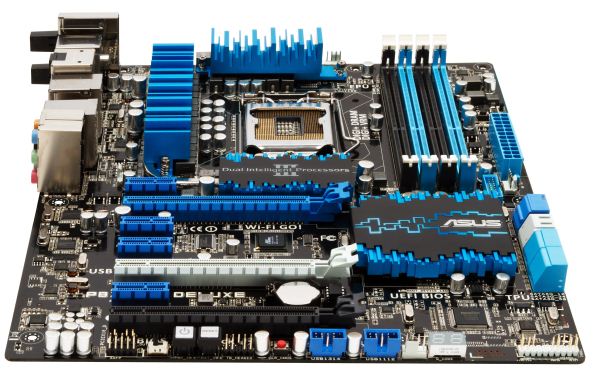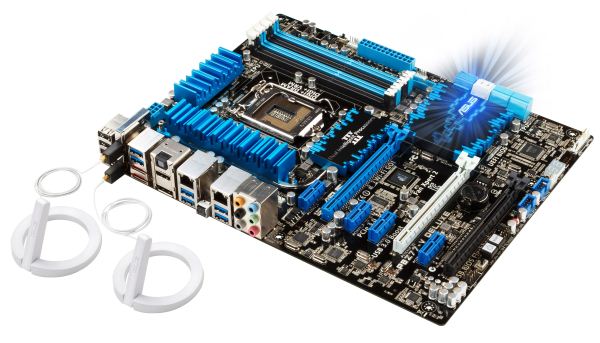Intel Z77 Panther Point Chipset and Motherboard Preview – ASRock, ASUS, Gigabyte, MSI, ECS and Biostar
by Ian Cutress on April 8, 2012 12:00 AM EST- Posted in
- Motherboards
- Intel
- Biostar
- MSI
- Gigabyte
- ASRock
- Asus
- Ivy Bridge
- ECS
- Z77
ASUS P8Z77-V Deluxe—Visual Inspection
In the next notch up in the channel board segregation, ASUS sell the Deluxe. This will be the first ASUS Deluxe board we have reviewed at AnandTech since the Llano mini-ITX F1A75-I Deluxe last year. In comparison to the P8Z77-V Pro, the Deluxe features several upgrades in terms of functionality and comfort.
The first to note is the increased power delivery to the CPU—this time in the form of a 16 + 4 phase power delivery. As a result, the VRM heatsinks to the left of the CPU are directly connected via a heatpipe to another heatsink below the socket. Also on board are the ‘enthusiast’ power/reset buttons and two-digit debug that we did not see on the Pro, and the use of dual NICs on the I/O, in the form of an Intel 82579V and a Realtek 8111F.
Due to the positioning off the heatsinks on the Deluxe compared to the Pro, the socket area seems a bit smaller (for example, the left hand heatsink is moved further in towards the socket), meaning that big air coolers may have a tougher time if they do not fit into Intel’s socket specification. Around the socket itself, we still have access to five fan headers—two 4-pin on the top of the board, one 4-pin to the bottom left of the main VRM heatsink, and one 4-pin either side of the 24-pin ATX power connector. A sixth fan header on board is found at the bottom next to the two-digit debug output.
Above the main power connector on the right hand side are the MemOK button and the TPU switch (for a fast automatic overclock). Below it is a USB 3.0 header, and a set of eight SATA ports. Similar to the ASUS Pro, we have four SATA 3 Gbps from the PCH, two SATA 6 Gbps also from the PCH, and two SATA 3 Gbps from a different controller—the Marvell 9128. This allows RAID 0/1 on these two SATA 6 Gbps ports.
The south side of the board still contains front panel headers and USB 2.0 ports, but also comes with the aforementioned power/reset buttons and two-digit debug display. We also find a ClearCMOS button on board, useful for overclockers. There is also a header labelled 'TB_Header', which should mean Thunderbolt, but there is no mention of it in the specifications. I will have to check up on this.
Update: The TB_Header is actually for a new Thunderbolt add-in card that ASUS will be selling. This is aimed to go into the x4 slot and provide Thunderbolt connectivity. MSRP will be around the $30-$40 mark so I am told.
In terms of the PCIe, we have a little bit of confusion. While in the middle between the PCIe is a PLX chip, it is not the PLX PXE 8747 chip that increases PCIe lane count. The one on the Deluxe is just to provide extra data transfer access for the various controllers on the motherboard. This means that the third full length PCIe in black is like other boards in that this is a PCIe 2.0 x4, non-GPU port. So from the top, we have a PCIe x1, x16 (x8 in Multi-GPU), x1, x1, x8, x1, x4. As a result, there is no PCIe to PCI bridge chip on this high-end model for PCI slots.
For the back panel, ASUS have done a juggling act deciding what to include. On the far left is a set of four USB 2.0 ports (black), a mini-PCIe WiFi + Bluetooth module, two USB 3.0 (blue), two eSATA, optical SPDIF output, HDMI output, DisplayPort, dual gigabit Ethernet, another four USB 3.0 ports (blue), a BIOS flashback button, and audio outputs. So in the name of a double NIC and 10 total USB ports on the back panel, we have lost D-Sub, DVI, IEEE1394 and a ClearCMOS button.
Board Features
| ASUS P8Z77-V Deluxe | |
| Size | ATX |
| CPU Interface | LGA-1155 |
| Chipset | Intel Z77 |
| Power Delivery | 16 + 4 |
| Memory Slots |
Four DDR3 DIMM slots supporting up to 32 GB Up to Dual Channel |
| Video Outputs | DisplayPort, HDMI |
| Onboard LAN |
Intel 82579V Realtek 8111F |
| Onboard Audio | Realtek ALC898 |
| Expansion Slots |
2 x PCIe x16 Gen3 (x16, x8/8) 1 x PCIe x16 Gen2 (x4) 4 x PCIe x1 Gen2 |
| Onboard SATA/RAID |
2 x SATA 6 Gbps (PCH), Support for RAID 0, 1, 5, 10 2 x SATA 6 Gbps (Marvell PCIe 9128), RAID 0, 1 4 x SATA 3 Gbps (PCH), Support for RAID 0, 1, 5, 10 2 x eSATA 6 Gbps (ASMedia) |
| USB |
Four USB 3.0 at rear (2 PCH, 2 ASMedia) Two USB 3.0 headers on board (PCH, ASMedia) Eight USB 2.0 (4 back panel, 4 on board) |
| Onboard |
4 x SATA 6 Gbps 4 x SATA 3 Gbps 1 x USB 3.0 Headers 2 x USB 2.0 Headers 6 x Fan Headers 1 x SPDIF Header 1 x Front Panel Audio Header 1 x TB Header MemOK! Button TPU/EPU Switches USB Flashback Button Power/Reset Buttons |
| Power Connectors |
1 x 24-pin ATX connector 1 x 8-pin 12V connector |
| Fan Headers |
1 x CPU Fan Header (4-pin) 4 x CHA Fan Headers 1 x OPT Fan Header |
| IO Panel |
2 x eSATA 6 Gbps 1 x DisplayPort 1 x HDMI 1.4a 2 x Gigabit Ethernet 6 x USB 3.0 4 x USB 2.0 1 x Optical SPDIF Audio Outputs Bluetooth V4.0 Wifi USB Flashback |
| Warranty Period | 3 Years |
| Product Page | Link |
Obviously one of the main selling points of the board is the onboard WiFi and Intel NIC (alongside a Realtek NIC).














145 Comments
View All Comments
Iketh - Sunday, April 8, 2012 - link
I'm curious how Skyrim behaves with this Lucid technology, since physics and framerate are linked for whatever reason... (if you disable Skyrim's 60 fps cap and point the camera in a direction that gives you 150+ FPS for example, everything that is moveable nearby starts to rattle and fall off shelves...)Xale - Sunday, April 8, 2012 - link
Games with their own framerate limits should not be affected, as long as that limit is preserved. They already simply 'pause' internally if the machine is too fast. It might go absolutely crazy though if you do forcefully disable that mechanism.Concillian - Sunday, April 8, 2012 - link
Am I reading that right? Z75 offers most of what even enthusiasts would want?So... why are there a crapton of Z77 boards in here and no Z75s?
Z75 supports 2 way crossfire / SLI, overclocking, 6Gbps SATA, native USB3.0... these are the features all but a tiny handful of users should be interested in.
By all rights Z75 should be the definitive chipset for the average enthusiast. Unless I'm missing something major, I hope there is significant attention paid to the Z75 chipset in reviews, because I'm failing to see why any but the most extreme users and those with money to burn would choose the Z77.
MrSpadge - Sunday, April 8, 2012 - link
Actually the ones with less money to burn might choose Z77 over Z75 to avoid investing in a huge SSD. The difference between chipset prices are usually small (what the motherboard manufacturer makes out of this is another question entirely).GreenEnergy - Sunday, April 8, 2012 - link
I find SSD caching to be some desperate dinosaur attempt. Mainly fueled by HD makers. Hybrid HDs are in the same basket. And yes, pick one, Z77 or Z75. The other one makes no sense.Z77, Z75 and H77 chipsets are priced at US$48, US$40 and US$43.
If SRT basicly cost 8$. Then its time for it to go away as the stillborn tech it is.
Zoomer - Tuesday, April 10, 2012 - link
The difference is mainly software and development, and should go away. SSD caching is a great idea that, imo, should optimally be on the filesystem level, not on the block level.*Looks at OS / filesys developers* (ZFS has some of it)
And oh, I expect lower end derivatives to come out eventually.
Nje - Sunday, April 8, 2012 - link
I was really excited about this motherboard - was kind of disappointed to see it is not part of this roundup. But I guess there will be other tests. Thanks for the preview - I look forward to the benchmarks, particularly if asus' memory technology works well, and if memory bandwidth plays more of a role on Ivy Bridge.Articuno - Sunday, April 8, 2012 - link
Things like overclocking being restricted to specific chipsets is really disappointing. AM3+ boards are generally cheaper than equivalent Intel boards and they don't lock features like this.MrSpadge - Sunday, April 8, 2012 - link
I suppose it's being done to make power delivery cheaper on these boards. Personally I don't like it either.GreenEnergy - Sunday, April 8, 2012 - link
I think you should visit Newegg. LGA1155 and AM3+ boards are just as cheap. And CPU wise...its just a disaster for AMD.